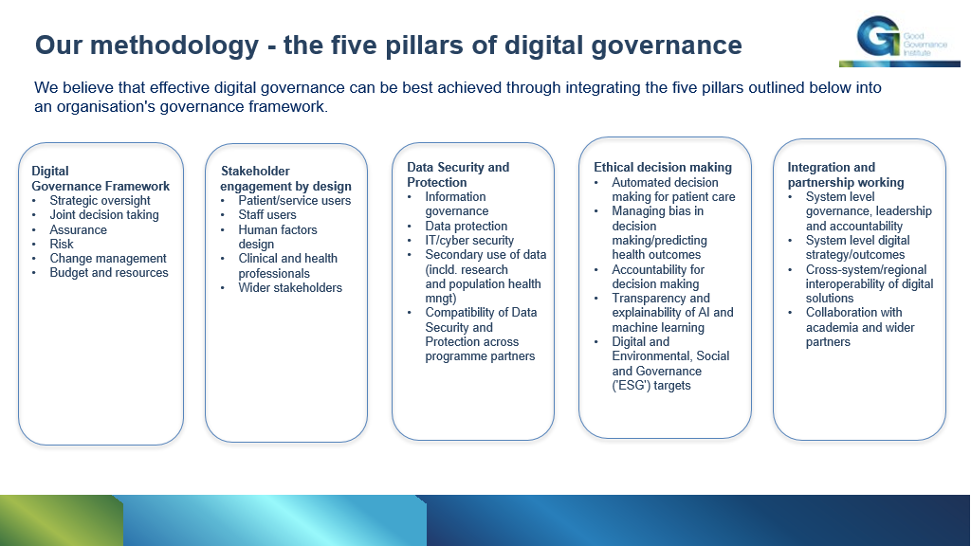The five pillars of digital governance
25 July 2022
GGI’s digital governance framework could help you make practical progress in this important aspect of modern governance. GGI debunks the myth that you need to be an expert to integrate solid digital governance into existing frameworks.
Many boards are grappling with what digital governance is and what they should be doing about it.
- What do all board members really need to know and focus on?
- Is digital governance an integral part of the core governance of the organisation or something a bit specialist off to one side of the board?
- More fundamentally, what does the board mean by digital governance?
Digital governance is a key component of modern governance. GGI has developed a simple-to-use digital governance framework for organisational leaders with little or no digital experience. We trust that our five-pillar tool will help to develop the skills and understanding leaders need to improve the value they add to their organisation.
What is digital governance and why is it important?
Digital governance requires the board to consider how technology impacts every activity in an organisation. Technology can be employed to prevent people from making mistakes and enable decisions to be better informed, made faster and easier and improve accountability by recording every interaction.
Ultimately, good digital governance justifies the investment in the hardware, software time and training required to implement digital technologies, because it makes it easier to do the right thing and almost impossible to do the wrong thing, while fulfilling the mission of the system or organisation.
Digital is no longer just a technological enabler. In high-performing organisations it plays a central role in defining organisational culture and strategy and maximising the impact an organisation has on those it serves.
How mature is your digital governance?
The first diagnostic around digital governance is simple. Ask yourself two questions.
- Do you recognise any of the statements below as being a genuine part of your organisational strategy, aims or objectives?
- If your answer is yes to any statement, how strong is the evidence you have for this?
Digital plays a central role in:
- delivering safe, effective and cost-efficient services and patient care
- empowering individuals to manage themselves and their own services, for example around customer interface or healthcare and wellbeing
- supporting staff to do their jobs more effectively and efficiently
- planning future services and delivering on the population health management agenda
- supporting strategic collaborative working and joint decision-making with partners
- undertaking balanced, fair and informed organisational decision-making
- delivering organisational transformation programmes
- developing reputation as a forward-thinking and ethics-driven organisation
- meeting sustainability targets.
This illustrates why having good digital governance in place is so important to help organisations deliver on their strategic objectives.
What does good digital governance look like in practice?
It is important to understand that digital governance doesn’t have to be complex or require specific expertise in the digital field. Think of it like quality or financial governance – board members are not all qualified professionals or specialists. If you have the right frameworks and structures in place that allow your board members to do strategic thinking, challenge and seek assurance, your board is already in a position to do effective digital governance.
An effective board spends time looking at how digital strategy supports the delivery of the organisational strategy, aims and objectives.
This puts the focus on effective oversight, accountability and assurance for digital being a collective responsibility at a strategic level, without seeing digital as something that should be left to technical experts.
GGI has developed a digital governance framework based upon ‘five pillars of digital governance’ that boards can integrate easily into their current governance frameworks.

Let's take a closer look at the first and fourth of these five pillars and the practical markers of progress for an organisation and its board.
Pillar One – Digital governance framework
- Financial scrutiny and oversight
- Accountability for performance of digital strategy
- Risk management that provides effective oversight
- Managing change well
- Effective assurance that systems are robust and reliable
- Responsible individuals and committees
- Strategy that is properly resourced with clear aims and objectives
Pillar Four – Ethical decision-making
- Stakeholders – The organisation has in place the right forum attended by the right people to assess and make decisions about the impact of implementing new digital technologies and the use of information or data about its key stakeholders. Key stakeholders may include the individuals your organisation sets out to deliver a service to, your staff and key strategic partners.
- Quality – The organisation has reviewed its understanding of data quality to ensure that the information received by the board to make strategic decisions meets wider ethical requirements. For example, the information received does not discriminate against a certain set of individuals. This could be achieved through undertaking equality impact assessments as part of an organisation’s data quality processes.
- Upgrade – The above digital impact decisions are linked to the organisation’s upgraded risk management processes and are seen by the board when they are likely to impact upon strategic delivery or the reputation of the organisation.
- Assurance – The board is confident that effective assurance structures are in place to ensure the organisation is meeting its regulatory responsibilities in relation to the development and implementation of digital technology – for example, around data protection, human rights and equalities legislation.
- Delivering ESG – The board has considered how digital will support it in meeting its environmental, social and governance (ESG) goals or targets, for example in relation to carbon emissions. This is clearly laid out in the organisation’s digital strategy for which the board has oversight for delivery.
Contact us to start a conversation about how our digital framework might work for you.
